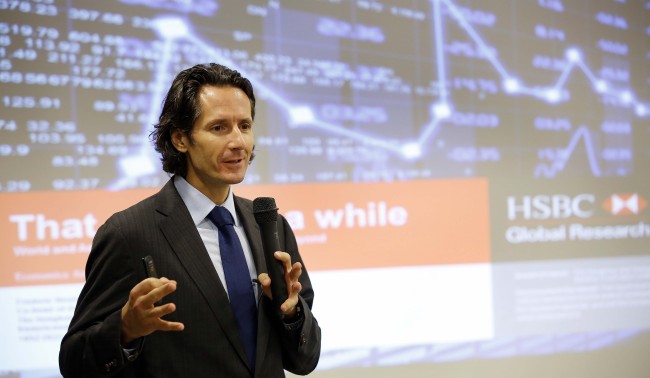Monetary easing useful for growth, not for restructuring: HSBC
By Park Hyung-kiPublished : May 3, 2016 - 15:41
In a seminar on the Korean economy, Neumann, the head of HSBC’s Asian Economic Research, said that Korean quantitative easing is not QE in the conventional sense as practiced by other central banks like the Federal Reserve, European Central Bank or the Bank of Japan.

“The Korean economy can afford monetary easing. I will welcome more monetary easing, but there is a fine line between fiscal and monetary policies,” he pointed out.
“Recapitalizing policy banks is a fiscal matter. I do think that yes, more easing is warranted because growth is weak.”
He suggested that Korea review policy banks’ balance sheets and consider strengthening them, whether through the Bank of Korea or otherwise.
His view on stimulus comes as the economist expects Korea to launch more fiscal and monetary measures in the face of weaker growth, and growing internal and external risks.
He said that there are many ways to revive Korea’s industrial sector using both monetary and fiscal policies.
“Korean QE can be understood as a form of fiscal policy executed by the central bank,” the economist said in an email statement.
“The precise mix depends on the circumstances, but in general it’s easier to keep monetary policy targeted at inflation and broader financial conditions and to use fiscal policy for more targeted measures.”
The Finance Ministry and the Bank of Korea were recently at odds over proposed steps for corporate restructuring. The Finance Ministry suggested the need for the central bank to launch quantitative easing by investing in bonds of policy banks, which will in turn finance restructuring. The central bank said that debt restructuring of companies should be handled through fiscal measures. Printing and pumping money into the market is considered the last stimulus option for central banks after lowering benchmark interest rates when in crisis. However, BOK recently said that it will support the government’s restructuring efforts.
The HSBC economist said that unlike in the late 1990s, Korea is not facing financial risks, but rather structural risks because of weak exports to the West where the U.S. manufacturing industry is going through a recession and Europe has high unemployment.
These external negative factors will continue to slow Korean exports to the West over the next two years.
HSBC forecast Korea to grow 2.2 percent this year, and 2.4 percent next year, with the central bank to cut its base rate by 25 basis points this year.
“Debt is not really a concern in Korea because it is internally financed, like we owe debt to ourselves,” Neumann said.
“Korea’s financial fundamentals are sound. The prospects for exports are murky. A patch for weak growth will take a while, which is not associated with financial risks.”
China’s slowdown will be another challenge for Korea, the economist said, noting that China’s property construction sector began to slow down in 2014 after growing 20 percent on-year.
The sector, which includes steel and cement, accounts for 22 percent of China’s gross domestic product, and is more than three times that of the U.S at its peak before the mortgage bubble in 2008.
“Korea is directly affected by China’s slowdown, and (it) indirectly also suffers because it is dependent on the global commodity cycle,” he said.
“We see a gradual rebound (in China’s property construction), but (it) will not benefit Korea like China did in the past because global commodity will not rebound as before.”
HSBC projects China to grow between 6.5 percent and 7 percent, and it is unlikely to grow above 7 percent as the world’s second largest economy seeks to stabilize growth through structural changes.
By Park Hyong-ki (hkp@heraldcorp.com)












![[Today’s K-pop] BTS pop-up event to come to Seoul](http://res.heraldm.com/phpwas/restmb_idxmake.php?idx=644&simg=/content/image/2024/04/17/20240417050734_0.jpg&u=)




![[KH Explains] Hyundai's full hybrid edge to pay off amid slow transition to pure EVs](http://res.heraldm.com/phpwas/restmb_idxmake.php?idx=652&simg=/content/image/2024/04/18/20240418050645_0.jpg&u=20240419100350)

![[Today’s K-pop] Zico drops snippet of collaboration with Jennie](http://res.heraldm.com/phpwas/restmb_idxmake.php?idx=642&simg=/content/image/2024/04/18/20240418050702_0.jpg&u=)